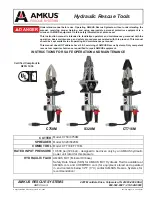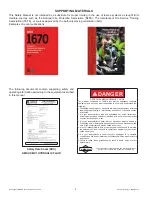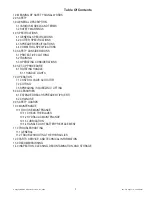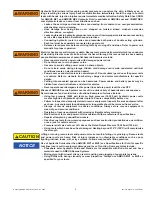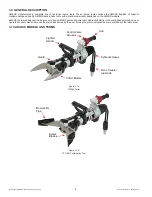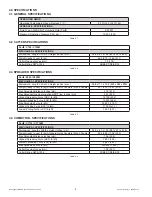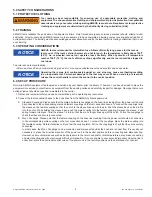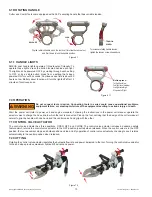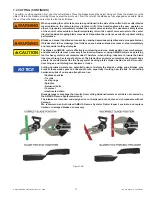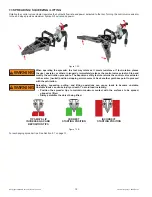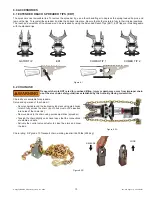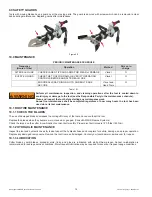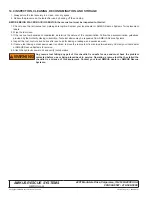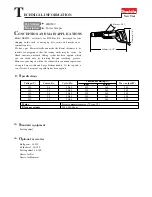
©Copyright AMKUS Rescue Systems, Inc. 2020
LAL-001 August 11, 2020 Rev01
4
1.0 MEANING OF SAFETY SIGNAL WORDS
A safety related message is identi
fi
ed by a safety alert symbol and a signal word to indicate the level of risk involved with a particular
hazard. Per ANSI standard Z535.6, the de
fi
nitions of the four signal words are as follows:
DANGER
DANGER indicates a hazardous situation which, if not avoided, will result in death or serious
injury.
WARNING
WARNING indicates a hazardous situation which, if not avoided, could result in death or serious
injury.
CAUTION
CAUTION indicates a potentially hazardous situation which, if not avoided, could result in minor
or moderate injury.
NOTICE
NOTICE is used to address practices not related to physical injury.
2.0 SAFETY
DANGER
Hydraulic tools can apply many tons of force which can bend, move, or lift large loads storing
potential energy. Loads can become unstable and suddenly move without warning causing
severe injury or death. Never support a load solely by a rescue tool. Use secondary supports to
limit the extent of uncontrolled movements. Never put body parts in a situation where a shifting
or falling load can cause a crushing injury. Stay clear of the path of travel.
• Metal-on-metal contact is likely to slide sideways when the load is not able to deform around
the area of contact. Use care when lifting structural and hardened objects.
• Chains can break when overloaded or improperly loaded.
• Spreader tips and rams can kick (move) when direction of force isn’t perpendicular to load
• Loads can suddenly shift sideways when forced, lifted, or moved. Stabilize load to reduce risk
of movement from ice, gravel, soft ground, precarious positions, objects which can break,
wheels which depressurize or roll, and loading which can change during rescue operations.
WARNING
Operating rescue tools can result in injury or death from laceration, projectile (high speed
fl
ying debris), and pinch point injuries. Stay clear of the path of travel. Avoid unnecessary risk.
Examples include:
• Never lift, or hold a rescue tool by its cutting blades or spreader arms. Never place hands
between moving tool and a load. Pinch points are created from tool movement causing risk of
limb amputation (i.e.
fi
ngers, hands, arms, feet, legs).
• Sharp metal objects formed during cutting and extrication cause potential for laceration and
puncture wounds
• Projectiles can be ejected during cutting, spreading, or lifting operations when objects break
suddenly under load. Sudden fractures are common with springs and hardened steels.
• Damaging pressurized objects such as airbag cylinders can create projectiles.
• Using a rescue tool beyond its reasonable lifespan increases risk of fatigue failure. Expected
lifetime of the tool is 10 years from the date of manufacture.
• Tools can drift (move side-to-side) as load is applied or released resulting in body parts being
trapped and crushed between tool handles and stationary objects. Always be aware of body,
hand, and
fi
nger position. Stop before harmful contact is made.
WARNING
Using rescue tools can cause ignition or explosion resulting in injury or death. Ignition or
explosion can result from situations such as:
• Flammable hazards are created when fuel lines, refrigerant lines (atomized oil), or pressurized
hydraulic
fl
uid lines are breached. Ignition sources can suddenly ignite these fuels.
• Flammable vapors can be released by careless refueling or operation of gasoline driven
engines. Refer to engine manufacturer’s manuals for speci
fi
c details.
• Extrication tools can create sparks as metals are cut and deformed. Avoid unnecessary risk
when
fl
ammable vapors are present.
• Power units with electric motors or internal combustion engines are ignition sources.
• Flammable vapors heavier than air can accumulate in low spots. Avoid selecting these
locations when setting up the power units. Use detectors to verify safe site selection.

